LEAN WITH LAZARUS
Ian R. Lazarus
Lean with Lazarus | Ian R. Lazarus
This month let’s look at how to best walk the tightrope between satisfying customers, stakeholders, and budgets.
A Process for All Reasons

In my last column, I talked about a common obstacle to building enduring quality in products and processes subject to continuous improvement, that is, the desire for rich and flexible design. This becomes a case where product managers can come to regret what they wished for.
Of course, if saying “no” to customer demands were that simple, we’d embalm a fundamentally good product or process in amber and call it a day, right? If only! This month let’s shine a light on another challenge to sustaining quality and how to best walk the tightrope between satisfying customers, stakeholders, and budgets.
We know for starters that processes are dynamic. This is true particularly in any industry with labor-intensive activities that cut across multiple boundaries. Think about automotive or aerospace industries. Since many readers won’t be working in those industries, let’s use an example that most everyone has experienced: that dreaded visit to the Emergency Room. Here the patient will potentially interact with a triage nurse, radiology staff, laboratory, pharmacy, attending physician, and others. They may be moved from exam room to radiology, to an operating room, and finally recovery.
Let's shine a light on another challenge to sustaining quality and how to best walk the tightrope.
The comfort of the patient should be given high priority in how we design the processes that will be provided. However, processes often evolve for the convenience of the staff working in the process, rather than the customer moving through the process. I’ll never forget working with a nationally recognized health system to assist in the redesign of their women’s surgical suite and maternity ward. Among other things, they had women that gave birth in the same recovery room as women that lost their baby – an untenable situation with joy and grief in close quarters. What I will remember however is the rebellious look on the nurse’s face when she learned that she would have to give up some of the space under her jurisdiction to solve this problem. She was likely an excellent nurse – but her perspective needed calibration.
When you are frustrated as a customer of a business that failed to meet your expectations, you may also find evidence of this phenomenon. This is not necessarily the fault of the person on the other side of the counter who must tolerate your complaints; it is a manifestation of a process that has evolved over time where the focus on the customer has been lost. It is unfortunate that the evolution of these processes becomes institutionalized without anyone ever stepping back to look at how the whole experience works - from the customer’s point of view. In Lean terminology we call this the “Voice of the Customer.”
Next, we have the situation where staff has designed their own approach to product or service delivery, confident in their view that the approach taken is the best. However, we all know that there is very likely only one “best practice” that will give rise to the best outcome for our customer. This phenomenon is clearly demonstrated by “Little’s Law,” which demonstrates the performance of multiple processes and its impact on cycle time or waiting time.

If you have ever found yourself waiting for services longer than reasonable, you are likely subject to this phenomenon. At a certain point, the process will experience an exponential rise in wait time because the capacity of the process has been reached. In this illustration, the lowest line is the most efficient. Staff has normalized around best practices. In the upper line we have a situation of different people doing the same thing, but differently.
If you operate a call center and your phone recording has a permanent warning that “your wait time may be longer than usual,” then what did “usual” ever look like? It is an oxymoron to have average wait times longer than usual! It is more likely that Little’s Law is exacting its punishment on managers (and their customers) that are oblivious to how it dictates performance levels.
Returning to the Emergency Room experience, when these facilities begin to experience demand beyond their capacity, their only option is to divert patients to other facilities. They are not addressing the problem; they are kicking the can down the road. The more sensible approach is to understand the difference between the lines, to eradicate any variation giving rise to the early bend in the line, and perhaps jump down to the lowest line to push the process to higher levels of production. The call center should do the same thing.
This is the kind of thinking inherent in the Lean and Six Sigma methodologies. In my next column, we will address the final obstacle that must be understood and overcome before successful implementation of these methods.